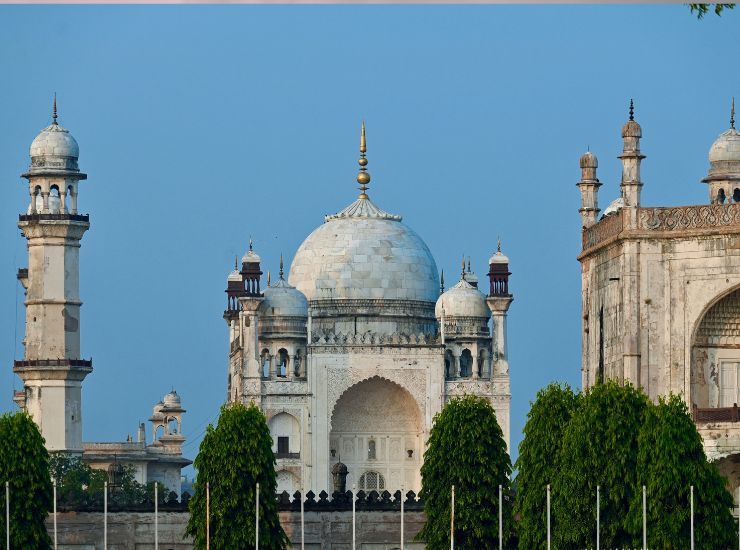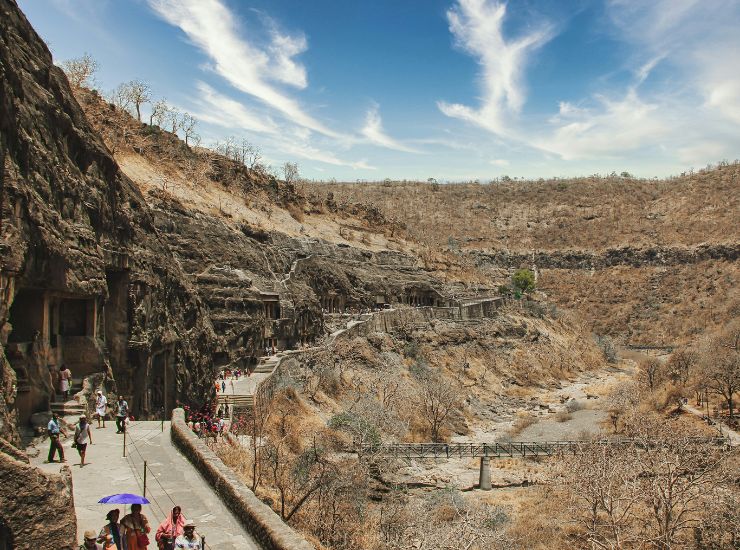Maharashtra Tour
Explore the Diversity of Maharashtra
Maharashtra offers a vibrant blend of ancient heritage, modern cities, spiritual centers, and scenic landscapes. From the bustling metropolis of Mumbai to the tranquil beaches of Konkan, the rock-cut wonders of Ajanta and Ellora to the sacred town of Shirdi, this tour presents the best of Maharashtra’s cultural and natural splendor.
Maharashtra Tourism
Located in the northern center of peninsular India, Maharashtra is surrounded by the Arabian sea in the west, Gujarat and Madhya Pradesh on the north, Madhya Pradesh in the east and Karnataka and Andhra Pradesh on the south. Mumbai is the capital of Maharashtra, which derives its name from the Goddess Mumba Devi.
Mughal rulers from Delhi tried their best to keep this region under their control. From the middle of the 17th century, a new group of warrior people came to dominate the scene in Maharashtra and elsewhere in India called Marathas. The origin of Marathas is still debatable, but what is known is that they stole the limelight from the great Mughals and at one point of time even captured Delhi. It was only after defeating the Marathas that the English could establish their rule in India. Shivaji was the first great ruler of Marathas and it was he who paved the way for future Maratha influence on India.
Bombay (Mumbai)
Mughal rulers from Delhi tried their best to keep this region under their control. From the middle of the 17th century, a new group of warrior people came to dominate the scene in Maharashtra and elsewhere in India called Marathas. The origin of Marathas is still debatable, but what is known is that they stole the limelight from the great Mughals and at one point of time even captured Delhi. It was only after defeating the Marathas that the English could establish their rule in India.
Shivaji was the first great ruler of Marathas and it was he who paved the way for future Maratha influence on India.
Mumbai (till recently known as 'Bombay') derives its name from the local deity Mumba Devi, whose temple is still there. The Portuguese predecessors of the British preferred to think of the name as Bom Baim, the Good Bay. Bombay was once a cluster of seven islands called Heptanasia by Plotemy in AD 150. Mumbai is home to people of all Indian creeds and cultures.

Altitude: Sea level, Climate: (deg C)-Summer- Max 33.3, Min 22.7; Winter- Max 29.5, Min- 19.4, Rainfall: 212 cms (June to September), Seasons: Throughout the year
Places Of Interest
Afghan Church, Chowpatty Beach, Gateway Of India, Haji Ali Tomb, Flora Fountain, Kamala Nehru Park, Crawford Market, Mahalakshmi, Marine Drive, Hanging Garden, Race Course, Rajabai Towers & Bombay University, Victoria Terminus , Nehru Planetarium, Taraporewala Acquarium , Jijamata Udyan, Nehru Science Centre, Prince Of Wales Museum.
Excursions
Aarey Milk Colony- 35 kms, Bassein Fort- 77 kms, Elephanta Caves- 9 kms, Gorai Beach- 59 kms, Juhu Beach- 21 kms, Kanheri Caves- 42 kms, Karla Caves-100 kms, Karnala Bird Sanctuary- 61 kms, Madh, Marve & Manori Beaches, Powai Lake -26.6 kms, Vihar Lake- 28.6 kms, Tansa Lake- 10.3 kms, Tulsi Lake- 32 kms, Vaitarna Dam- 122 kms, Vajreshwari- 88 kms, Sanjay Gandhi National Park- 35 kms.
Reach
By Air: Bombay is well linked to major cities of India.
By Rail: Well connected by to all major cities and towns of India.
By Road: Pune-163 kms, Nasik-185 kms, Mahabaleshwar- 239 kms, Shirdi- 307 kms, Aurangabad- 392 kms, Vadodara- 432 kms, Ahmedabad- 545 kms, Panaji- 597 kms, Hyderabad- 711 kms, Bangalore- 998 kms.
Pune (Poona)
Located in Sahyadri hills near the west coast of India, Pune is a fascinating city with a healthy climate all year around.The city was one of the pivotal basesof the 17th century great Maratha ruler Chhatrapati Shivaji, who was born at the Shivneri Fort here.Pune became the seat of the enterprising Peshwas, under whom Maratha power rose into a major political force. The Peshwas were renowned patrons of the arts and in their time, enriched the city with temples, gardens and educational institutions.
It was here that Lokmanya Bal Gangadhar Tilak introduced the principle of Swadeshi during the Freedom Movement.Today Pune is one of the leading metros in India, with the Film and Television Institute of India and National Defence Academy based here.
Altitude: 598 meters, Climate: (deg C)-Summer- Max 40, Min 26; Winter- Max 29, Min 19, Rainfall: 70 cms (June to September), Best season: Throughout the year.
Places Of Interest
Shaniwar Wada, Saras Baug, Parvati Hill, Raja Kelkar Museum, Shinde's Chhatri, Bund Garden, Kasturba Smarak (Inside Agha Khan Palace) etc.
Excursions
Alandi- 22 kms, Dehu- 29 kms, Karla- 55 kms, Purandhar- 40 kms, Sinhagad- 25 kms, Panchgani- 98 kms, Mahabaleshwar-120 kms, Shivneri Fort- 94 kms, Bhima Shankar- 95 kms, Ashtavinayak Temples at Theur- 20 kms, Ranjangaon- 50 km, Morgaon- 65 km, Madh- 75 kms, Ojhar- 75 kms, Pali- 80 kms, Lenyadri- 90 kms & Siddhatek- 95 kms, Lonavala- 64 kms, Bhatghar Dam- 52 kms.
Reach
By Air: Well connected with Bombay.
By Rail: Pune is well linked by rail with all major towns.
By Road: Bombay-170 kms, Shirdi- 195 kms, Nasik- 202 kms, Aurangabad- 226 kms.
Aurangabad - Ajanta & Ellora
Malik Ambar, the Prime Minister of Murtaza Nizam Shah II, founded the city of Aurangabad in 1610 A.D, on the site of a village, Khirki. When Fateh Khan, Malik Ambar's son succeeded the throne in 1626, he named the city 'Fatehpur'. In 1653, when Aurangzeb became the Viceroy of the Deccan, he made it his capital, and renamed it Aurangabad. Maurya rule heralded the advent of Buddhism in the state of Maharashtra. The earliest caves at Ajanta and Pithalkora were excavated in the 2nd century BC, during the Satvahana era. Paithan, then known as Pratishthana, was an important trade centre at the time.
Aurangabad, 400 kms from Bombay, is linked by air too. Spectacular rock cut caves and cave paintings exist at two nearby places, Ajanta and Ellora.

Altitude: 513 meters, Climate: (deg C)-Summer- Max 39, Min 21.5; Winter- Max 31.3, Min 10, Rainfall: 557 mms, Seasons: Throughout the year
Places Of Interest
Aurangabad Caves, State Archaeological Museum, Nehru Udyan, History Museum of Marathwada University, Bibi ka Maqbara, Panchakki, Siddharth Udyan.
Excursions
Daulatabad Fort-13 kms, Khuldabad- 26 kms, Grishneshwar Temple- 30 kms, Paithan- 56 kms, Shirdi-136 kms, Pithalkhora Caves- 78 kms, Aundha Nagnath-203 kms, Ajanta-106 kms, Ellora- 30 kms.
Reach
By Air: Well linked with major cities of India.
By Rail: Well connected by to all major cities and towns of India.
By Road: Ajanta- 106 kms, Bombay- 392 kms, Ellora- 30 kms, Nanded- 272 kms, Nasik- 221 kms, Pune- 229 kms, Shirdi- 136 kms.
Ajanta
It was only in the 19th century, that the Ajanta group of caves, lying deep within the Sahyadri hills, cut into the curved mountain side, above the Waghora river, were discovered. A group of British officers on a tiger hunt, stumbled on these ancient works of art. They depict the story of Buddhism, spanning the period from 200 BC to 650 AD.

The 29 caves were built as secluded retreats of the Buddhist monks, who taught and performed rituals in the Chaityas and Viharas, the ancient seats of learning, and nerve - centres of the Buddhist cultural movement.
Using simple tools like hammer and chisel, the monks carved out the impressive figures adorning the walls of these structures.
Reach
By Air: The nearest airport Aurangabad is -106 kms.
By Rail: The nearest railhead is Jalgaon- 60 kms and Aurangabad– 106kms.
By Road: Aurangabad- 106kms, Ellora- 70kms. Jalgaon- 60kms.
Ellora
The Ellora caves, 34 in number, are carved into the sides of a basaltic hill, 30 kms from Aurangabad. The finest specimens of cave - temple architecture, they house elaborate facades and exquisitely adorned interiors. These structures representing the three faiths of Hinduism, Buddhism and Jainism, were carved during the 350 AD to 700 AD period.
The 12 caves to the south are Buddhist, the 17 in the centre dedicated to Hinduism, and the 5 caves to the north are Jain.
Reach
By Air: The nearest airport Aurangabad is -30 kms. from Ellora
By Rail: The nearest railhead is Aurangabad- 30 kms. from Ellora
By Road: Aurangabad- 30kms, Ajanta-76kms.
Mahableshwar
Not far from Pune and Mumbai is Mahableshwar, the most popular hill station in Maharashtra, located at an altitude of 1372 meters. A number of vantage points, excellent views, pretty waterfalls and a lake with boating and fishing facilities are some of its major attractions.
Places Of Interest
Walks and excursions to viewing points such as Elphistone Point, Babington Point, Bombay Point, Kate’s Point and waterfalls like Chinaman’s Falls and Dhobi Falls are pleasant, Venna Lake and Panchganga Temple.
Excursions
Pratapgarh Fort, and Panchgani.
Reach
By Air: Nearest airport is Pune- 120kms.
By Rail: Nearest railhead is Pune- 247kms.
By Road: Bombay- 290kms, Pune-247kms.
Customize Your Maharashtra Tour
This is a private individual tour and can be fully customized to suit your available days, travel preferences, and budget. Our experts are ready to help you create a bespoke tour just for you.
To get started, please contact us with the following details:
- Number of days for touring in India.
- Period of travel (Month of the year)
- Number of people travelling.
- Choice of destination in India (North, South, East, West)
- Choice of Hotels accommodation (Economy, Standard, First Class, Premium)
Send us an email on info@tour-india.net or submit the form with your queries, we will reply you with your tour within 24 hrs. *
East India
West India
North India
South India
Plan Your Journey Today
Ready to explore the wonders of India? Contact us to customize your tour package and embark on a journey of a lifetime.
